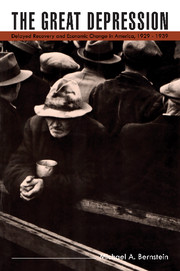Book contents
- Frontmatter
- Contents
- List of tables
- List of figures
- Editors' preface
- Preface
- Introduction: The puzzle of the 1930s
- 1 Long-term economic growth and the problem of recovery in the United States, 1929–39
- 2 The transformation of American industry in the interwar period
- 3 A reassessment of investment failure in the interwar economy
- 4 Technical change during the interwar years
- 5 The effective demand problem of the interwar period. I: Cyclical and structural unemployment
- 6 The effective demand problem of the interwar period. II: Cyclical and secular changes in final demand
- 7 New Deal economic policy and the problem of recovery
- 8 Contemporary economic problems in historical perspective
- Bibliography
- Index
6 - The effective demand problem of the interwar period. II: Cyclical and secular changes in final demand
Published online by Cambridge University Press: 06 July 2010
- Frontmatter
- Contents
- List of tables
- List of figures
- Editors' preface
- Preface
- Introduction: The puzzle of the 1930s
- 1 Long-term economic growth and the problem of recovery in the United States, 1929–39
- 2 The transformation of American industry in the interwar period
- 3 A reassessment of investment failure in the interwar economy
- 4 Technical change during the interwar years
- 5 The effective demand problem of the interwar period. I: Cyclical and structural unemployment
- 6 The effective demand problem of the interwar period. II: Cyclical and secular changes in final demand
- 7 New Deal economic policy and the problem of recovery
- 8 Contemporary economic problems in historical perspective
- Bibliography
- Index
Summary
Of course the … development of cheap luxuries has been a very fortunate thing for our rulers. It is quite likely that fish and chips, artsilk stockings, tinned salmon, cut-price chocolate … the movies, the radio, strong tea and the Football Pools have between them averted revolution. Therefore we are sometimes told that the whole thing is an astute manoeuvre by the governing class … to hold the unemployed down. What I have seen of our governing class does not convince me that they have that much intelligence. The thing has happened, but by an unconscious process.
– George OrwellThe effective demand problem of the 1930s primarily resulted from persistent unemployment, but cyclical and secular changes in consumer expenditures also played an important role in lengthening the depression. Related changes in the distribution of income also impeded recovery. These changes in consumer expenditures and income distribution provide additional insight as to why the industries that did recover quickly after 1932 nonetheless could not lead a general upturn.
With a massive deficit spending effort, perhaps on the scale of spending undertaken during World War II, consumption could have led the way out of depression. Given the political impossibility of such a strategy, recovery required investment growth. The industries that potentially might have provided such investment leadership were hampered by a low rate of growth in sales, due in part to the cyclical and secular changes in consumer spending discussed in the following sections.
- Type
- Chapter
- Information
- The Great DepressionDelayed Recovery and Economic Change in America, 1929–1939, pp. 170 - 183Publisher: Cambridge University PressPrint publication year: 1987

